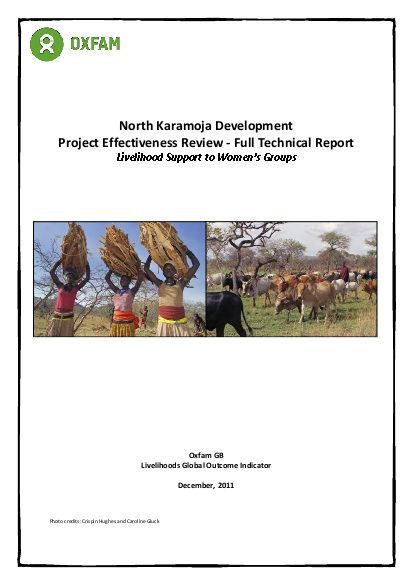
As per Oxfam Great Britain’s (OGB) Global Performance Framework (GPF), sufficiently mature projects are being randomly selected each year and their effectiveness rigorously assessed. Uganda’s Livelihood Diversification and Support Project was originally selected in this way under the livelihood strengthening thematic area. However, it was realised that this project was too immature to be subjected to an “effectiveness review”. Fortunately, it was identified as being connected to another project that is sufficiently mature, namely, the North Karamoja Development Project. Thus, a decision was taken to assess its effectiveness, including the extent to which it has promoted change in relation to OGB’s global livelihood outcome indicator: % of targeted households living on more than £1.00 per day per capita Through the North Karamoja Development Project and other complementary initiatives, OGB has been directly supporting 10 women’s groups, made up of over 400 members, in Kotido and Kaabong districts of Uganda’s Karamoja sub-region since 2007. This support primarily involved the construction and equipping of grain storage and milling facilities for each of the 10 groups and the provision of agricultural inputs and tools to their members. The women were also targeted with animal husbandry training, where they, among other things, were encouraged to utilise the services of animal health workers. Communal dams were also constructed to increase access to water for livestock owned by the members of the groups and wider community.. In August 2011, with the support of an external consultant, a household survey was administered to 188 randomly selected women from the groups, as well as 239 women from non-OGB supported groups in neighbouring communities. The survey comprised of questions not only relevant to the above indicator but also a number of other measures associated with the support’s other intended outcomes. In order to compare like with like, statistical analysis of the resulting data was undertaken using propensity score matching (PSM) and multivariable regression (MVR) to control for measured differences between the intervention and comparison women. Overall, no statistically significant difference was found between the two categories of women in relation to OGB’s global livelihood indicator, indicating that the support has not raised household income. Moreover and unfortunately, no overall differences between the intervention and comparison groups were identified for the other outcome measures as well. The picture is different, however, when the data are disaggregated by district. Positive and statistically significant differences were identified for the OGB supported women in Kotido district in the areas of food security and self-reported agricultural production and profits. In addition, the women of Kaabong district reported less livestock loss over time than their comparators. While there is little evidence to demonstrate that the support provided to the women has brought about any significant positive change, it is fully appreciated that the Karamoja sub-region is an exceptionally challenging development context. It is hoped that reflecting on the following programme learning considerations will enable the Oxfam Karamoja team to strengthen the Karamoja programme in general and the support that is being provided to the targeted women in particular: Assess whether Oxfam’s advocacy strategy for Karamoja is sufficiently relevant Review intervention implementation and uptake in both Kotido and Kaabong to identify why there are reported differences in impact between the two districts Review the portfolio of support being provided to the women’s groups and consider undertaking qualitative research to identify more focused support that is more likely to leverage substantive, sustainable change Explore the potential of investing more in agricultural production and commodity marketing Explore possibilities of supporting greater numbers of people with less resources